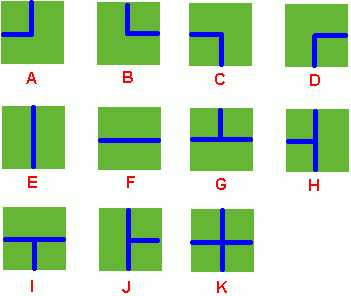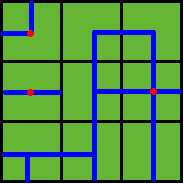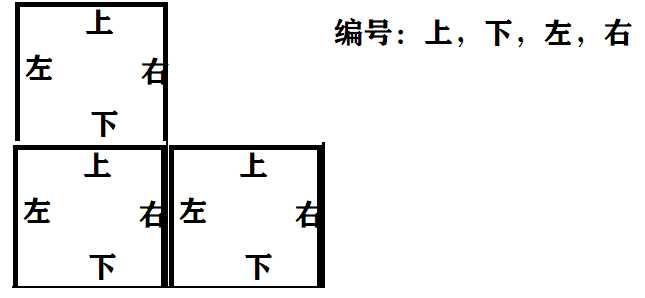标签:pes main 一个 NPU end iostream clu character ios

Benny has a map of his farm, which is an array of marks denoting the distribution of water pipes over the whole farm. For example, if he has a map
ADC
FJK
IHE
then the water pipes are distributed like

int mp[12][4]={ {1,0,1,0}, {1,0,0,1}, {0,1,1,0}, {0,1,0,1}, {1,1,0,0}, {0,0,1,1}, {1,0,1,1}, {1,1,1,0}, {0,1,1,1}, {1,1,0,1}, {1,1,1,1}, };
以此为判定连通:

1:DFS做法:以now[][]来储存输入的图,由now2[][]来记录对应mp[][]里的类型编号。每次深搜把四周搜一遍,可以连通就消掉,dfs的次数就是答案。类似之前的油田问题,只是这个题需要把地图转化。
#include<iostream> #include<cstdio> #include<cstring> #include<algorithm> #include<set> using namespace std; const int maxn=60; int mp[12][4]={ {1,0,1,0}, {1,0,0,1}, {0,1,1,0}, {0,1,0,1}, {1,1,0,0}, {0,0,1,1}, {1,0,1,1}, {1,1,1,0}, {0,1,1,1}, {1,1,0,1}, {1,1,1,1}, }; char now[maxn][maxn]; int now2[maxn][maxn]; bool vis[maxn][maxn]; int n,m; void dfs(int i,int j) { vis[i][j]=false; int s=now2[i][j]; int s2=now2[i-1][j]; int s3=now2[i+1][j],s4=now2[i][j-1],s5=now2[i][j+1]; for(int x=0;x<4;x++)//这wa了一次,因为我传入的是i,j,所以for里不要再int i了。 { if(x==0)//上 { if(mp[s][0]==1&&mp[s2][1]==1&&i-1>=0&&vis[i-1][j]==true) dfs(i-1,j); } if(x==1)//下 { if(mp[s][1]==1&&mp[s3][0]==1&&i+1<n&&vis[i+1][j]==true) dfs(i+1,j); } if(x==2)//左 { if(mp[s][2]==1&&mp[s4][3]==1&&j-1>=0&&vis[i][j-1]==true) dfs(i,j-1); } if(x==3)//右 { if(mp[s][3]==1&&mp[s5][2]==1&&j+1<m&&vis[i][j+1]==true) dfs(i,j+1); } } } int main() { while(scanf("%d%d",&n,&m)&&n!=-1&&m!=-1) { for(int i=0;i<n;i++) scanf("%s",now[i]); memset(vis,true,sizeof(vis)); for(int i=0;i<n;i++) { for(int j=0;j<m;j++) { now2[i][j]=now[i][j]-‘A‘; } } int ans=0; for(int i=0;i<n;i++) { for(int j=0;j<m;j++) { if(vis[i][j]==true) { ans++; dfs(i,j); } } } cout<<ans<<endl; } }
2:并查集做法。
看图可以看出,相连通的块可以放入一个集合里。结尾遍历一下所有点,有几个集合,就需要几个出水点。n*m,那么就是n*m个点,对它们进行合并操作即可。判断过程是,遍历每一个田地,对它进行check():看它的四周(注意出界情况),如果可以连通,就把本田地编号与可连通田地的编号进行合并。find()以及jion()均为并查集的最基本操作,没有进行改动。
#include<iostream> #include<cstdio> #include<cstring> #include<algorithm> #include<set> using namespace std; const int maxn=60; int mp[12][4]={ {1,0,1,0}, {1,0,0,1}, {0,1,1,0}, {0,1,0,1}, {1,1,0,0}, {0,0,1,1}, {1,0,1,1}, {1,1,1,0}, {0,1,1,1}, {1,1,0,1}, {1,1,1,1}, }; int pr[maxn]; int n,m; char now[maxn][maxn]; void init() { for(int i=1;i<=n*m;i++) pr[i]=i; } int find(int x) { if(x!=pr[x]) return pr[x]=find(pr[x]); return x; } void join(int x,int y) { int fx=find(x),fy=find(y); if(fx!=fy) pr[fx]=fy; return ; } void check(int i,int j,int k) { int s1=now[i][j]-‘A‘; if(i!=n-1) { int s2=now[i+1][j]-‘A‘; if(mp[s1][1]==1&&mp[s2][0]==1) join(k,k+m); } if(i!=0) { int s2=now[i-1][j]-‘A‘; if(mp[s1][0]==1&&mp[s2][1]==1) join(k,k-m); } if(j!=0) { int s2=now[i][j-1]-‘A‘; if(mp[s1][2]==1&&mp[s2][3]==1) join(k,k-1); } if(j!=m-1) { int s2=now[i][j+1]-‘A‘; if(mp[s1][3]==1&&mp[s2][2]==1) join(k,k+1); } } int main() { while(scanf("%d%d",&n,&m)&&n!=-1&&m!=-1) { init(); for(int i=0;i<n;i++) scanf("%s",&now[i]); int k=1; for(int i=0;i<n;i++) { for(int j=0;j<m;j++) { check(i,j,k); k++; } } int ans=0; for(int i=1;i<=n*m;i++) { if(pr[i]==i) ans++; // cout<<pr[i]<<" "; } cout<<ans<<endl; } }
PS:就本人代码来讲,dfs的速度比并查集快了将近一倍
HDU--1198 Farm Irrigation (并查集做法+DFS做法)
标签:pes main 一个 NPU end iostream clu character ios
原文地址:https://www.cnblogs.com/liyexin/p/12661716.html